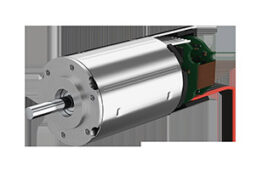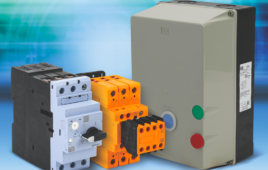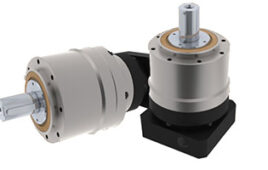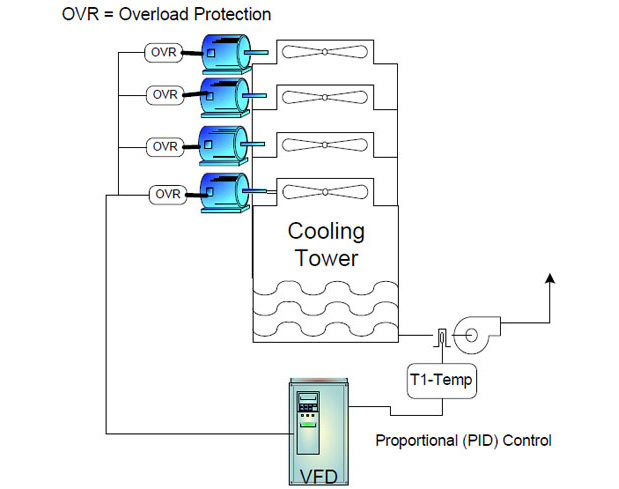Opto 22’s SNAP PAC System combines PAC Project software, SNAP PAC controllers, SNAP PAC brains, and SNAP I/O into a completely integrated, easy-to-use system designed to simplify the typically complex process of solving automation, monitoring, and data acquisition problems.
Opto 22’s new offerings focus on consolidating hardware to save space, simplifying the buying process for the customer by providing fewer, but more powerful models, as well as including a new automation suite which simplifies development time. A simulator is also available free for download from the company’s website, which makes it easy for users to see their strategies in an environment that simulates an actual SNAP PAC system programmable automation controller, and an enterprise connectivity software application simplifies exchange between enterprise databases.
Opto 22 announces the release of the following products to enhance its SNAP PAC System:
New Switched Dual Ethernet SNAP I/O Brains are an integral part of the new, simplified SNAP PAC system. They perform the same functions as seven previously offered Opto 22 brains and add new features. They simplify the customer’s decision-making process, making it easer to choose the right I/O processor. Additionally, five new higher-density I/O modules consolidate a large number of I/O points where panel space is restricted.
New SNAP PAC Racks simplify configuration in an I/O system, allowing users to mix any combination of modules on a single rack. Standardized mounting rack architecture reduces rack choices from fifteen to four, eliminating compatibility and configuration issues.
Opto 22 also announces the SNAP Motion Control Subsystem. By combining motion control with process control, sequential logic, string and data handling, math, and networking in a single PAC system, the SNAP Motion Control Subsystem helps complete the multi-domain functionality of the SNAP PAC System.
The SNAP PAC Sim executes SNAP PAC system control, monitoring, and data acquisition strategies with no hardware required. Engineers can download the software from Opto 22’s website free of charge and begin their application development in a virtual environment.
New software links SNAP PAC System with enterprise databases without cost and complexity of an HMI as middleware. It is ideal for users who need to simply and quickly exchange data among desktop or enterprise applications control, data acquisition, and monitoring using standard methods and file types. And it is easy to use because it is part of PAC Project and integrated into the SNAP PAC System.
PAC Project is a new automation software suite that makes developing applications for industrial automation, control, data acquisition, and remote monitoring much easier. Because PAC Project is specifically designed for use with Opto 22’s new SNAP PAC System, configuration, development, troubleshooting, and maintenance are much simpler. It is available in basic and professional versions. The basic version is free.
Refer to pricing information at the end of the document.
For more information, read the full article below, visit www.opto22.com, or call 951-695-3000. Scroll down to find the specific product of interest.
Switched Dual Ethernet SNAP I/O Brains
The SNAP-PAC-EB1 and SNAP-PAC-EB2 I/O brains, networked I/O processors, make designing Ethernet-based remote, distributed I/O systems easier and more cost effective. These new brains are an integral part of the new, simplified SNAP PAC System. Both processors have dual, switched 10/100 Mbps Ethernet interfaces, which lowers network equipment costs by making it possible to build multi-drop I/O networks over standard Ethernet cable. The built-in switches reduce the need for external, standalone Ethernet switches, and the daisy-chain configuration minimizes lengthy cable runs associated with traditional star-configuration Ethernet networks.

The SNAP-PAC-EB1 and SNAP-PAC-EB2 brains consolidate the capabilities of seven previously offered Opto 22 brains, while adding new features. With just two choices, it is significantly easier for customers to choose the right I/O processor for their applications. For example, the SNAP-PAC-EB1 boasts hardware-driven, high-speed digital functions for counting, quadrature input, pulsing, latching, and more, making it ideal for the high-speed digital requirements found in applications like sequential logic, motion control, and robotics; the SNAP-PAC-EB2 does not offer high-speed features, but provides counting and latching in the brain’s software. Otherwise, both SNAP PAC brains are identical, including features such as distributed intelligence, Ethernet networking, multiple protocol support, and SNAP I/O module compatibility. The brains include powerful processors that offload time-critical tasks from the host controller or PC. Functions such as counting, latching, thermocouple linearization, PID loop control, event messaging, scaling, engineering unit conversion, ramping, time-proportional outputs, and more are handled in the SNAP PAC brain. Ethernet networking with multiple simultaneous protocol support, including Modbus(r) /TCP, OptoMMP, FTP, TCP/IP, UDP/IP, SMTP, SNMP, and more, come standard. Finally, a SNAP PAC brain can address a mix of up to 512 points of analog, digital, serial, and special-purpose I/O on a single rack.
Increased Density of SNAP I/O Modules
Five new higher density I/O modules join the family of SNAP I/O for the SNAP PAC system: the 32-channel SNAP-AIMA-32 current input module and 32-channel SNAP-AIV-32 voltage input module; and the16-channel SNAP-IAC-16, SNAP-IAC-A-16, and SNAP-IDC-16 digital input modules. The increased density of each of these new modules reduces the system cost and the required panel space in applications where they are used. These new I/O modules are used to connect to and communicate with sensors, actuators, instrumentation, and equipment in industrial applications involving digital on/off control or the monitoring and acquisition of analog temperature, humidity, pressure, flow, and other types of data.
“These newest higher-density SNAP I/O modules are ideal for OEMs and other customers who’ve expressed a need for consolidating a large number of I/O points in smaller or confined spaces,” states Mark Engman, Opto 22 President and CEO. The SNAP-AIMA-32 provides 32 channels of -20 mA to +20 mA analog current input. The module can also be scaled for use anywhere within this operating range. It is transformer isolated and, like all Opto 22 SNAP modules, is optically isolated from the equipment and devices it connects to, as well as from other on a shared I/O rack.

The module offers +/- 25,000 counts of resolution and accuracy of 0.05% (10 microamps). The SNAP-AIV-32 provides 32 channels of analog voltage input. Each channel can be configured for -5 to +5 Vdc or -10 to +10 Vdc operation or scaled for use anywhere within these operating ranges. The module offers +/- 25,000 counts of resolution and accuracy of 0.05%, 5 mV at 10 Vdc or 2.5 mV at 5 Vdc. The SNAP-IAC-16 and SNAP-IAC-A-16 digital input modules each offer 16 points of input with channel-to-channel isolation. These modules can be used to sense on/off status for 90-140 Vac or 180-280 Vac, respectively. The SNAP-IDC-16 digital input module provides 16 points of input with channel-to-channel isolation. The module can be used to sense on/off status in the 10-32 Vdc range.
Simpliefied Racks for the SNAP PAC System
The new SNAP PAC racks make it simpler to configure an I/O system and reduce the number of spares needed, as customers seek to purchase, deploy, and maintain, control, automation, and data acquisition systems. They are used with rack-mounted SNAP PAC R-series programmable automation controllers (PACs) and new SNAP PAC brains. The SNAP PAC racks are available in four sizes and can accommodate 4, 8, 12, or 16 SNAP I/O modules, allowing up to 512 I/O points on a single rack. They allow users to mix any combination of analog, digital, serial, and special-purpose modules in any position on any rack. This flexibility, combined with standardized, consolidated mounting rack architecture, reduces the number of rack choices from fifteen to four, and eliminates confusion regarding compatibility and configuration of I/O in user applications.
SNAP PAC Motion Control Subsystem
The SNAP Motion Control Subsystem offers a cohesive development platform for applications that require motion control along with analog, digital, and serial control. The Subsystem combines a SNAP Motion host communication module in a SNAP I/O form factor, a SNAP Motion breakout board, and the OptoMotion command library for use with PAC Control, the control programming component of Opto 22’s PAC Project software suite. Combined, PAC Control and the SNAP Motion ControlSubsystem provide a set of integrated, easy-to-use tools that simplify application development where multi-axis stepper motor control is combined with traditional analog, digital, and serial-based automation and control.

Each SNAP-SCM-MCH-16 Motion host module can communicate with up to 16 axes of stepper motion, by using up to four SNAP-SCM-BB4 breakout boards, intelligent Magellan-based motion processors that accommodate up to 4 axes of stepper motion each. Because the breakout boards drive the stepper motors based on commands received serially from the host, the SNAP Motion Control Subsystem can act as a distributed, intelligent system delivering higher performance than traditional single-CPU motion control systems. The OptoMotion command set for PAC Control supports several Magellan Motion Processor commands. Users can define and acquire motion process data, such as position, velocity, acceleration, breakpoints, interrupts, and time intervals; and also execute motion-related actions such as smooth stops, abrupt stops, stepping, and position adjustments.
The SNAP Motion Control Subsystem provides an ideal, cost-effective approach to solving tough automation and motion problems for applications in aerospace, automotive, packaging, and other industries. This includes fabrication, registration, cutoff, winding, die cutting, and inspection processes involving hydraulic pumps, air cylinders, machine tools, and other equipment.
SNAP PAC Sim
SNAP PAC Sim is a software application that functions as an Opto 22 SNAP PAC programmable automation controller in a Microsoft Windows-based PC without the need for an external hardware controller. When combined, Opto 22’s SNAP PAC Sim and PAC Project software suite (available as a free download from the Opto 22 website) give users all the control programming, human-machine interface development, and debugging tools needed to design, build, and debug an industrial control, monitoring, and data acquisition application for the SNAP PAC system. Opto 22 website visitors have long been able to download, evaluate, and use SNAP PAC system software free of charge to familiarize themselves with Opto 22’s flowchart-based programming environment. The SNAP PAC Sim takes this a step further by letting users run the strategies they have created in an environment that simulates an actual SNAP PAC system programmable automation controller. Doing so allows control engineers, programmers, prospective customers, and others to learn more about SNAP PAC controllers, experience first-hand the tight integration between the Opto 22 hardware and software, and even begin their application development prior to laying out a capital expense. The SNAP PAC Sim will be available as a free download from Opto 22’s website, and will also be bundled with various SNAP PAC System software demos.
OptoDataLink
OptoDataLink, part of Opto 22’s PAC Project Professional software for the SNAP PAC System, is an enterprise connectivity software application used to create and facilitate bi-directional data exchange between the SNAP PAC System and enterprise databases, such as Microsoft(r) SQL Server(r), Microsoft Access, and MySQL, among others. OptoDataLink is an ideal software tool for users who need to simply and quickly exchange data among desktop or enterprise applications and control, data acquisition, and monitoring systems using standard methods and file types.
Applications that are well suited for OptoDataLink include recipe management, data archival, and data warehousing, as well as those where control system alarms need to be reported, acknowledged, and recorded at the enterprise level. OptoDataLink is easy to use because it is part of PAC Project and integrated into the SNAP PAC System. The control system tags for OptoDataLink are automatically created when the control startegy is developed. No re-creation of tag names is required. Because OptoDataLink is its own application, an HMI application is not required to be configured or running, the method used by many competing data link solutions. This advantage significantly reduces system configuration, development time, capital expense, and maintenance, resulting in a much lower total cost of ownership. Finally, OptoDataLink employs a simple, four-step form-based configuration interface. No experience with setting up technologies like ODBC or ADO.NET is required. Once configuration is complete, OptoDataLink runs in the background, communicating directly with databases and the SNAP PAC System.

PAC Project
The PAC Project software suite includes all of the control programming, human machine interface (HMI) development, and connectivity tools needed to design, develop, and maintain sophisticated industrial control, monitoring, and data acquisition applications. The affordability and single tagname database development environment of PAC Project make this software suite far less costly and more user-friendly than traditional automation software development tools. At the same time, tight integration with the SNAP PAC System hardware provides control programming, HMI development, and OPC connectivity that offer simplicity, versatility, and reliability at the industry’s most competitive price (the Basic version of PAC Project is free).
PAC Project is available in two versions: Basic and Professional. PAC Project Basic provides all the functionality required for most modern industrial applications and includes PAC Control(tm) for control programming, PAC Display(tm) for HMI development, and PAC Manager(tm) for system configuration. PAC Project Professional includes the same components, plus added features and applications for advanced networking, enterprise connectivity, and legacy hardware support. Control programming development is accomplished with PAC Project’s PAC Control. PAC Control-whose origins date back to 1991-is an intuitive, flowchart-based control programming and debugging tool that offers both a comprehensive, plain-English command set and a powerful advanced scripting language. PAC Control offers commands for analog process and digital sequential control, complex math, conditional branching, string handling, serial device control, subroutines, PID loop control, data arrays, and other complex functions-all within a single programming environment.
Additionally, PAC Project Professional supports configuration of the Opto 22 SNAP PAC controllers’ dual Ethernet interfaces to allow segmenting the control and I/O network from the business local area network (LAN), commands for use with legacy hardware control devices such as Optomux(r) and mistic(tm) systems, and importing of control strategies from legacy Opto 22 software applications like FactoryFloor’s OptoControl(tm). For HMI development, the PAC Project software suite also includes PAC Display, an HMI configuration and runtime application used to design and run operator interfaces on Microsoft Windows(r) -based clients. Utilizing PAC Display, SNAP PAC System users can create simple or elaborate graphical human-machine interfaces using an assortment of original or included industrial symbols, jpegs, and bitmaps. Support for alarm management, recipe handling, operator logging, real-time and historical trending, multimedia, and unlimited tags allows PAC Display to compare favorably against competing HMI development applications costing thousands of dollars more per seat.
The Professional version of PAC Project adds OptoOPCServer(tm), an OLE for Process Control (OPC) 2.0-compliant server used to consolidate and publish SNAP PAC System data to OPC-aware clients-including third-party HMIs such as Wonderware’s InTouch(r), Intellution’s iFix(r), aware clients-including third-party HMIs such as Wonderware’s InTouch(r), Intellution’s iFix, and Iconic’s Genesis(r). OptoOPCServer works with another PAC Project Professional component, OptoDataLink(tm), to create and facilitate a bi-directional data transfer link between the SNAP PAC System and enterprise databases, like Microsoft SQL Server, Microsoft Access, and MySQL, among others. Finally, PAC Project includes PAC Manager, a configuration and maintenance tool used to inspect and view I/O data associated with the control strategy in real-time.

Pricing List
The SNAP PAC brains will be available March 1, 2007.
List pricing for the SNAP-PAC-EB1 is $645 USD, and the SNAP-PAC-EB2 is $425 USD.
The new modules are available March 1, 2007 and are priced as follows:
USD SNAP-AIMA-32 – $995
USD SNAP-AIV-32 – $995
USD SNAP-IAC-16 – $182
USD SNAP-IAC-A – 16 $182
USD SNAP-IDC-16 – $182 USD
The new SNAP PAC racks will be available March 1, 2007. Pricing is as follows: SNAP-PAC-RCK4 – $125 USD
SNAP-PAC-RCK8 – $145 USD
SNAP-PAC-RCK12 – $155 USD
SNAP-PAC-RCK16 – $161 USD
The SNAP PAC Sim will be available as a free download from Opto 22’s website (www.opto22.com) and will also be bundled with various SNAP PAC System software demos.
OptoDataLink will be available March 1, 2007. OptoDataLink is included with the purchase of PAC Project Professional (at $995 USD) or available separately for $395 USD.
PAC Project Basic and Professional will be available March 1, 2007.
PAC Project Basic is available as a free download from Opto 22’s website at www.opto22.com. PAC Project Professional is priced at $999 USD.
Opto 22
www.opto22.com
Filed Under: Factory automation, Data acquisition + DAQ modules, I/O modules, CONNECTIVITY • fieldbuses • networks, Computer boards, ENGINEERING SOFTWARE, Microprocessors, Motion control • motor controls





Tell Us What You Think!